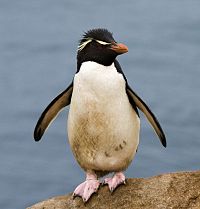
Photo from wikipedia
In arid and semiarid environments, water is a key resource that is limited in availability. During the dry season, perennial water sources such as water pans often are far apart… Click to show full abstract
In arid and semiarid environments, water is a key resource that is limited in availability. During the dry season, perennial water sources such as water pans often are far apart and shape the daily movement routines of large herbivores. In hot environments, endotherms face a lethal risk of overheating that can be buffered by evaporative cooling. Behavioral adjustments are an alternative way to reduce thermal constraints on the organism. The tradeoff between foraging and reaching water pans has been studied widely in arid environments; however, few studies have looked into how ambient temperature shapes individual trips between two visits to water. In this study, we tracked during the dry season the movement of eight GPS-collared African elephants (Loxodonta africana) cows from different herds in Hwange National Park, Zimbabwe. This species, the largest extant terrestrial animal, is particularly sensitive to heat due to its body size and the absence of sweat glands. We show that most foraging trips depart from water at nightfall, lowering the average temperature experienced during walking. This pattern is conserved across isolated elephant populations in African savannas. We also observed that higher temperatures at the beginning of the trip lead to shorter trips. We conclude that elephants adjust the timing of foraging trips to reduce the thermal constraints, arguing that further considerations of the thermal landscape of endotherms are important to understand their ecology.
Journal Title: Journal of Mammalogy
Year Published: 2020
Link to full text (if available)
Share on Social Media: Sign Up to like & get
recommendations!